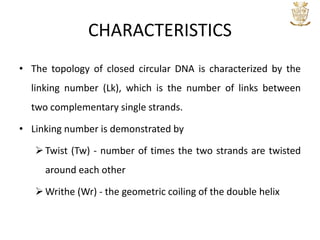DNA TOPOLOGY
- 1. DNA TOPOLOGY DR. ANU P. ABHIMANNUE ASST. PROFESSOR, DEPARTMENT OF BIOTECHNOLOGY, ST.MARY’S COLLEGE, THRISSUR.
- 2. DNA TOPOLOGY • Dictionary explains topology as “The study of geometrical properties and spatial relations unaffected by the continuous change of shape or size of figures” • The topology of DNA, explains how the two complementary single strands are intertwined. • DNA topology encompasses supercoiling, knots, and catenanes. Dr. ANU P A, ST. MARY'S COLLEGE, THRISSUR 2
- 3. CHARACTERISTICS • The topology of closed circular DNA is characterized by the linking number (Lk), which is the number of links between two complementary single strands. • Linking number is demonstrated by Twist (Tw) - number of times the two strands are twisted around each other Writhe (Wr) - the geometric coiling of the double helix
- 4. KNOTS • Entanglement of flexible curves leads to knots
- 5. CATENANES • Topologically linked circular DNA molecules are called Catenanes. • Usually, they appear at the end of replication of circular DNA.
- 6. SUPERCOILING • Super coiling refers to the additional twisting of a DNA strand • Advantage of supercoiling – Reduce the space required for DNA packaging, allowing for more efficient storage of DNA • First observed by Jerome Vinograd at the California Institute of Technology in 1963. Vinograd: (February 9, 1913 – July 7, 1976), American biochemist
- 7. OBSERVATION • Jerome Vinograd and his colleagues observed two closed, circular DNA molecules of identical molecular mass exhibit very different rates of sedimentation during centrifugation. • Further analysis indicated that the DNA molecule sedimenting more rapidly had a more compact shape because the molecule was twisted upon itself and occupies a smaller volume and moves more rapidly
- 8. When same type of molecule in a supercoiled state and relaxed state is subjected to gel electrophoresis, the highly compact, supercoiled form moves rapidly. The same when subjected to ultra-centrifugation, supercoiled DNA settles at the bottom more faster. SUPER COILING
- 9. Overwound DNA • Positive supercoiling • Positive supercoiling of DNA occurs when it is twisted even tighter until the helix begins to distort and "knot.“ • Rarely DNA forms positive supercoiling eg: positive supercoils in front of the transcription site Underwound DNA • Negative supercoiling • Involves twisting against helical conformation which preferentially underwinds and "straightens" at low twisting stress, and knots the DNA into negative supercoils at high twisting stress. • Most DNA is negatively supercoiled. Eg: Circular DNAs like mitochondrial, viral, Bacterial and eukaryotic chromosome.
- 10. ENZYMES IN DNA TOPOLOGY • Topoisomerases – enzymes that change the topology of the DNA. • The first DNA topoisomerase was discovered by James Wang in 1971 • Cells contain a variety of topoisomerases • Broadly classified as • Type I topoisomerases • Type II topoisomerases Chinese-born American biochemist and biologist
- 11. Topoisomerases Type I topoisomerases • It create a transient break in one strand of DNA • Convert supercoiled DNA to relaxed form. • Plays significant role during DNA replication and transcription Type II topoisomerases • Transient break in both strands • It can supercoil and relax DNA, tie a DNA molecule into knots or untie; cause a population of independent DNA circles to become interlinked (catenated ) or vice versa. • Human topoisomerase II is a target for drugs (e.g., etoposide and doxorubicin) to prevent resealing of DNA in rapidly dividing cells and are therefore used in the treatment of cancer
- 12. Topoisomerases Type I topoisomerases • Mechanism : enzyme cleaves one strand and then allows the intact, complementary strand to undergo a controlled rotation, which relaxes the supercoiled molecule. Type II topoisomerases • Mechanism: Another segment of the DNA molecule is transported through the break, and the severed strands are resealed.
- 13. REFERENCES • Gerald Karp (2010). Cell and molecular biology: concepts and experiments (6th ed.). John Wiley & sons. ISBN-13 978-0-470-48337-4. • Neuman K.C., 2010. Single-molecule Measurements of DNA Topology and Topoisomerases. J Biol Chem. 285(25): 18967–18971. doi: 10.1074/jbc.R109.092437 • https://ib.bioninja.com.au/higher-level/topic-7-nucleic-acids/71-dna- structure-and-replic/supercoiling.html • http://earth.callutheran.edu/Academic_Programs/Departments/BioDev/o mm/topo1/frames/coil.htm#:~:text=Positive%20supercoiling%20of%20DN A%20occurs,twisting%20in%20a%20left%2Dhanded












